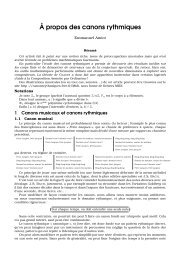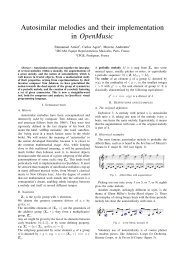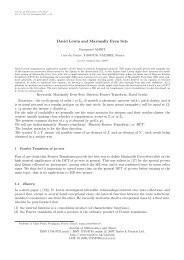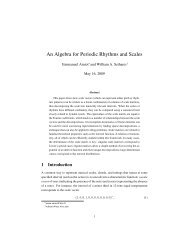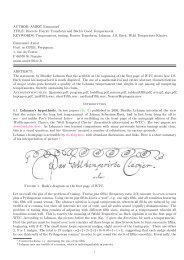Emmanuel Amiot Modèles algébriques et algorithmes pour la ...
Emmanuel Amiot Modèles algébriques et algorithmes pour la ...
Emmanuel Amiot Modèles algébriques et algorithmes pour la ...
Create successful ePaper yourself
Turn your PDF publications into a flip-book with our unique Google optimized e-Paper software.
GGGE♭ 25<br />
as a c − b = b + c by hypothesis.<br />
From there we g<strong>et</strong> immediately S(f k (x)) = f k (S(x)) and hence S(Ox) ⊂ O S(x). By symm<strong>et</strong>ry (reasoning<br />
on S −1 which is none other than S itself !) the inclusion is an equality. <br />
These examples open a new alley for future research, combining inner symm<strong>et</strong>ries (the autosimi<strong>la</strong>rity)<br />
of a melody with outer symm<strong>et</strong>ries (e.g. inversion), using some structural features of the space of musical<br />
events.<br />
8 Online Supplementary II: about general affine maps<br />
Here we consider what happens when iterating an affine map that is not bijective.<br />
8.1 Universal property<br />
Theorem 6.1, establishes autosimi<strong>la</strong>r melodies as universal objects. Musically this means that one hears<br />
an autosimi<strong>la</strong>r melody after several augmentations of any periodic melody.<br />
The iteration of any affine map f modulo n (not one to one) eventually reduces to iterating an affine trans-<br />
formation on some subs<strong>et</strong> of Zn.<br />
Mathematically, it means that the submelody M = f p (M) = <br />
Mf p (k) is autosimi<strong>la</strong>r by some power of<br />
k∈Z<br />
f: f q [ M] = M for some p, q > 0.<br />
Proof The s<strong>et</strong> (algebraically, a monoid) of all affine maps modulo n is finite. Thus the sequence of powers<br />
of f will only take a limited number of different values. So there must exist two different exponents p, p + q<br />
with f p = f p+q . Now for any r > p,<br />
f r+q = f (p+q)+(r−p) = f p+q ◦ f r−p = f p ◦ f r−p = f p+(r−p) = f r<br />
We have just shown that the sequence of powers of f is ultimately periodic. So is for any x ∈ Zn, the<br />
sequence f k (x). This means that after p iterations of f, any further iteration of f q will preserve the<br />
sequence. <br />
8.2 A Fitting ending<br />
We will round up this <strong>la</strong>st theorem with a more d<strong>et</strong>ailed exp<strong>la</strong>nation in the simpler case of homoth<strong>et</strong>ies,<br />
which links this result with the abstract Fitting Lemma already connected with several musicological<br />
situations (Anatol Vieru’s iteration of the difference operator, [5]). 1 A connection to the general case is<br />
that the ultimate period of f ∈ Affn : x ↦→ a x + b is a multiple of the ultimate period of its linear part<br />
f : x ↦→ a x.<br />
L<strong>et</strong> us consider this map x ↦→ a x mod n. First we will assume for simplicity’s sake that gcd(a, n) = p<br />
is a prime factor. This means n = p m q where q is coprime with p. Now x ↦→ a x maps Zn into the cyclic<br />
subgroup of index p, namely p Zn, isomorphic with Zp m−1 q. After m iterations we are working in p m Zn,<br />
cyclic subgroup of Zn isomorphic with Zq. There x ↦→ a x is one-to-one, at long <strong>la</strong>st.<br />
Proposition 8.1 The attractors Ax = {a k x, k ≥ m} are the orbits of f : x ↦→ a x operating on Z/qZ,<br />
identified to subgroup p m (Z/nZ).<br />
1 It is worth noticing that orbits, for homoth<strong>et</strong>ies, or their difference s<strong>et</strong>s, for general affine maps, are exactly the eigenvectors of<br />
Vieru’s difference operator acting on subs<strong>et</strong>s of Zn:<br />
∆(x, a x, a 2 x . . . ) = (a x − x, a 2 x − a x, . . . ) = (a − 1)(x, a x, a 2 x . . . )




